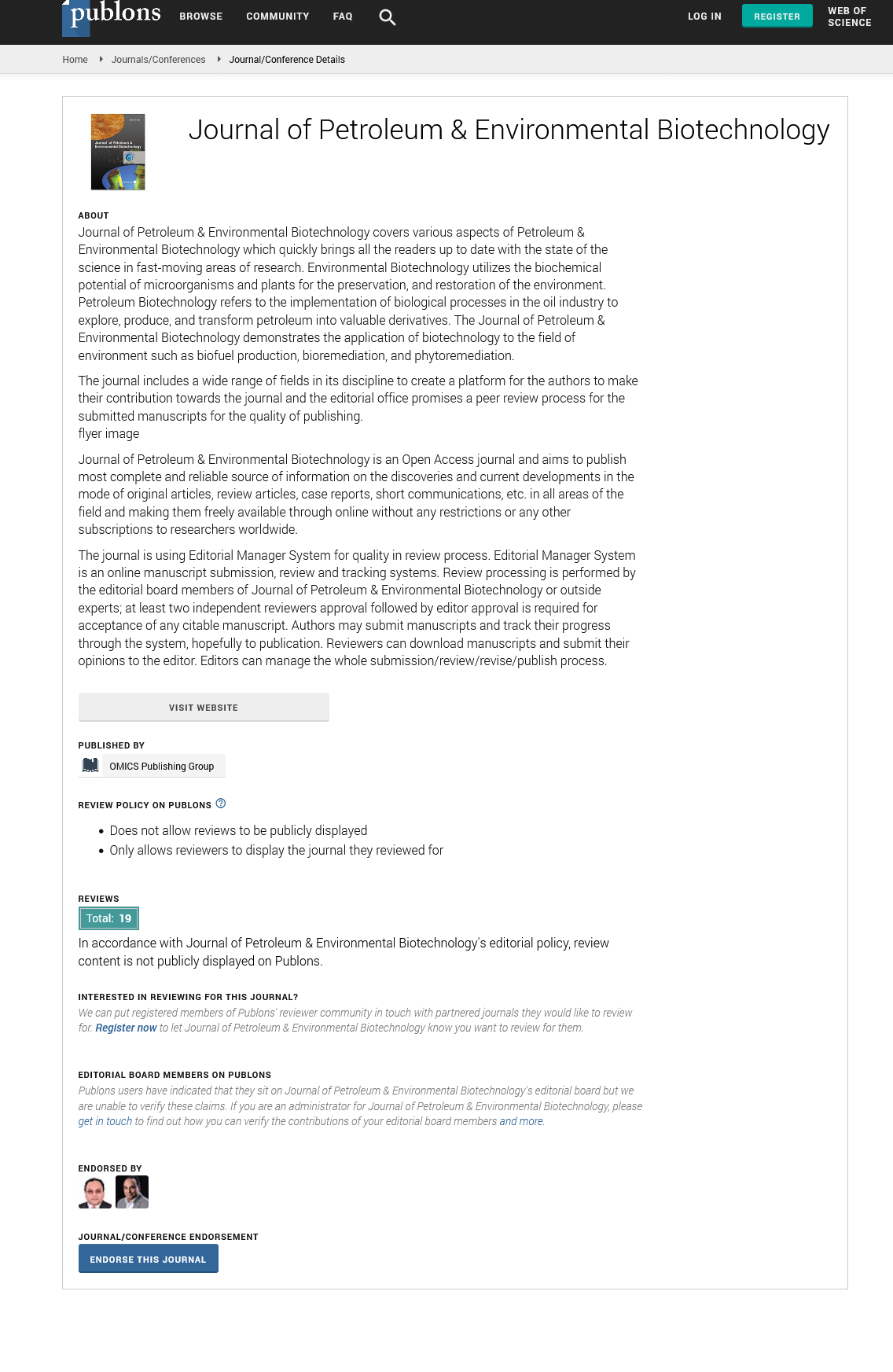Indexed In
- Open J Gate
- Genamics JournalSeek
- JournalTOCs
- China National Knowledge Infrastructure (CNKI)
- Electronic Journals Library
- RefSeek
- Hamdard University
- EBSCO A-Z
- OCLC- WorldCat
- SWB online catalog
- Virtual Library of Biology (vifabio)
- Publons
- MIAR
- Euro Pub
- Google Scholar
Useful Links
Share This Page
Journal Flyer

Open Access Journals
- Agri and Aquaculture
- Biochemistry
- Bioinformatics & Systems Biology
- Business & Management
- Chemistry
- Clinical Sciences
- Engineering
- Food & Nutrition
- General Science
- Genetics & Molecular Biology
- Immunology & Microbiology
- Medical Sciences
- Neuroscience & Psychology
- Nursing & Health Care
- Pharmaceutical Sciences
Articles published in Journal of Petroleum & Environmental Biotechnology have been cited by esteemed scholars and scientists all around the world. Journal of Petroleum & Environmental Biotechnology has got h-index 39, which means every article in Journal of Petroleum & Environmental Biotechnology has got 39 average citations.
Following are the list of articles that have cited the articles published in Journal of Petroleum & Environmental Biotechnology.
| 2024 | 2023 | 2022 | 2021 | 2020 | 2019 | 2018 | 2017 | 2016 | 2015 | 2014 | 2013 | 2012 | 2011 | 2010 | |
|---|---|---|---|---|---|---|---|---|---|---|---|---|---|---|---|
Total published articles |
40 | 56 | 60 | 53 | 18 | 16 | 31 | 38 | 61 | 57 | 35 | 43 | 34 | 12 | 4 |
Research, Review articles and Editorials |
3 | 15 | 10 | 13 | 8 | 11 | 1 | 35 | 53 | 53 | 30 | 33 | 21 | 8 | 4 |
Research communications, Review communications, Editorial communications, Case reports and Commentary |
20 | 41 | 50 | 40 | 10 | 5 | 30 | 3 | 8 | 4 | 5 | 10 | 13 | 4 | 0 |
Conference proceedings |
23 | 8 | 5 | 14 | 5 | 0 | 100 | 168 | 168 | 118 | 175 | 188 | 89 | 0 | 0 |
Citations received as per Google Scholar, other indexing platforms and portals |
488 | 589 | 699 | 790 | 653 | 601 | 563 | 460 | 389 | 349 | 171 | 70 | 20 | 36 | 0 |
| Journal total citations count | 5903 |
| Journal impact factor | 1.72 |
| Journal 5 years impact factor | 2.78 |
| Journal cite score | 20.15 |
| Journal h-index | 39 |
Important citations
MUTHUSAMY PD (2014) HEAVY METAL TOLERANCE AND ORGANIC COMPOUNDS UTILIZATION IN ESCHERICHIA SP. ORIGINATED FROM WASTEWATER (Doctoral dissertation, Universiti Teknologi Malaysia).
Agarry SE, Oghenejoboh KM (2014) Biodegradation of Bitumen in Soil and Its Enhancement by Inorganic Fertilizer and Oxygen Release Compound: Experimental Analysis and Kinetic Modelling. J Microbial Biochem Technol S 4: 2.
Lukić B, Huguenot D, Panico A, Fabbricino M, Van Hullebusch ED, Esposito G (2016) Importance of organic amendment characteristics on bioremediation of PAH-contaminated soil. Environmental Science and Pollution Research 23: 15041-52.
Nduka JK, Anyakora C, Obi E, Obumselu FO, Ezenwa TE, et al. (2013) Polyaromatic hydrocarbons (PAHs) and inorganic chemical contaminants at refuse dumpsites in Awka, South Eastern Nigeria: a public health implication. Journal of Scientific Research & Reports 2: 173-89.
Agarry SE, Jimoda LA (2013) Application of carbon-nitrogen supplementation from plant and animal sources in in-situ soil bioremediation of diesel oil: experimental analysis and kinetic modelling. Journal of Environment and Earth Science 3: 51-62.
Pandey A, Banerjee D (2015) Daldinia bambusicola Ch4/11 an Endophytic Fungus Producing Volatile Organic Compounds Having Antimicrobial and Olio Chemical Potential.
Kudalkar PS (2016) Physiological characteristics of fungi associated with antarctic environments (Doctoral dissertation, MONTANA STATE UNIVERSITY Bozeman).
Hipol RM, Broñola-Hipol RL (2016) Carboxylesterase activity of fungi isolated from Marchantia polymorpha. World 5: 23-5.
Pryor O, Barari G, Koroglu B, Lopez J, Nash L, et al. (2016) Shock Tube Ignition Studies of Advanced Biofuels. In52nd AIAA/SAE/ASEE Joint Propulsion Conference p. 4691.
Qiu R, Qu D, Trengove R, Agarwal M, Hardy GE, Ren Y (2014) Headspace solid-phase microextraction and gas chromatography-mass spectrometry for analysis of VOCs produced by Phytophthora cinnamomi. Plant Disease 98: 1099-105.
Mallette ND (2013) Volatile fuel & organic compound production by Ascocoryne sarcoides: exploration of environmental variables and analytical methods (Doctoral dissertation, Montana State University-Bozeman, College of Engineering).
Liarzi O, Bar E, Lewinsohn E, Ezra D (2016) Use of the endophytic fungus Daldinia cf. concentrica and its volatiles as bio-control agents. PloS one 11: e0168242.
Bosso L, Scelza R, Varlese R, Meca G, Testa A, et al. (2016)Assessing the effectiveness of Byssochlamys nivea and Scopulariopsis brumptii in pentachlorophenol removal and biological control of two Phytophthora species. Fungal biology 120: 645-53.
Ulloaâ€Benítez Á, Medinaâ€Romero YM, Sánchezâ€Fernández RE, Lappeâ€Oliveras P, Roqueâ€Flores G, et al. (2016) Phytotoxic and antimicrobial activity of volatile and semiâ€volatile organic compounds from the endophyte Hypoxylon anthochroum strain Blaci isolated from Bursera lancifolia (Burseraceae). Journal of applied microbiology 121: 380-400.
Gomes AA, Queiroz MV, Pereira OL (2015) Mycofumigation for the Biological Control of Post-Harvest Diseases in Fruits and Vegetables: A Review. Austin J Biotechnol Bioeng 2: 1-8.
Strobel G, Ericksen A, Sears J, Xie J, Geary B, et al. (2017) an Endophyte of Dicksonia antarctica, Making a Fragrant Mixture of Biologically Active Volatile Organic Compounds. Microbial Ecology 10: 1-0.
Askar MB, Moghadam MF (2013) Research and Reviews: Journal of Engineering and Technology.
Monggoot S, Popluechai S, Gentekaki E, Pripdeevech P (2017) Fungal Endophytes: an Alternative Source for Production of Volatile Compounds from Agarwood Oil of Aquilaria subintegra. Microbial Ecology 5: 1-8.
Barari G, Pryor O, Koroglu B, Sarathy SM, Masunov AE, et al. (2017) High temperature shock tube experiments and kinetic modeling study of diisopropyl ketone ignition and pyrolysis. Combustion and Flame 177: 207-18.
Strobel G (2014) The use of endophytic fungi for the conversion of agricultural wastes to hydrocarbons. Biofuels 5:447-55.

